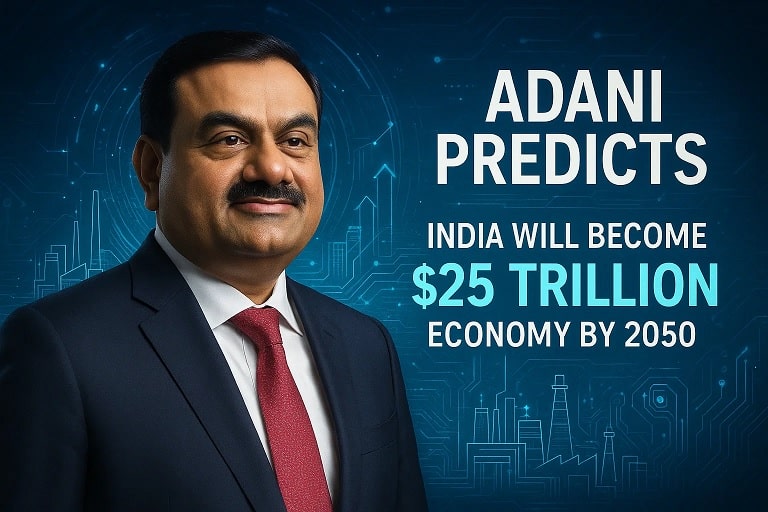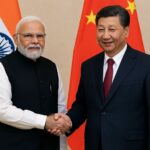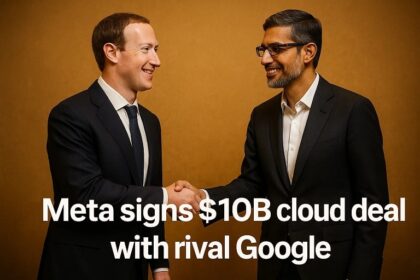On August 7, 2025, Gautam Adani, Chairman of the Adani Group, delivered an inspiring address at the Indian Institute of Management (IIM) Lucknow, predicting that India will transform into a $25-$30 trillion economic powerhouse by 2050. Speaking to students, Adani outlined a vision driven by India’s demographic dividend, rising consumer demand, robust digital infrastructure, and growing domestic capital. He projected that within the next decade, India will add $1 trillion to its GDP every 18 months, positioning it as the world’s third-largest economy by 2030 and second-largest by 2050, with a stock market capitalization exceeding $40 trillion. Adani’s ambitious forecast, reiterated from earlier speeches in 2022 and 2023, emphasizes bold innovation and India’s civilizational values as key to redefining global economic leadership.
Background of the Prediction
India, currently the world’s fifth-largest economy with a GDP of $4.19 trillion in 2025, has shown rapid growth, adding $1 trillion to its GDP in just five years (2020-2025), compared to 58 years for the first trillion post-independence. Adani’s forecast, first articulated at the 2022 India Economic Conclave and the 2023 Adani Enterprises AGM, builds on projections from the United Nations Population Fund, which estimates India’s population will grow 15% to 1.6 billion by 2050, with a median age of 38. Per capita income is expected to surge 700% to $16,000, or 3-4 times higher on a purchasing power parity basis.
Adani’s optimism is rooted in four key drivers: demographics (a young, ambitious workforce), demand (rising consumption), digital infrastructure (Aadhaar, UPI, ONDC), and domestic capital (Indian investors backing local ideas). He cited the Adani Group’s own growth—36% EBITDA increase to ₹57,219 crore and 82% profit after tax growth to ₹23,509 crore in FY 2022-23—as evidence of India’s economic potential. Projects like AdaniConneX’s 1 GW data center and the Dharavi Redevelopment Project underscore his focus on transformative infrastructure.
Key Drivers of India’s Economic Growth
Demographic Dividend: India’s young population, with a median age of 38 in 2050, will drive consumption and tax revenue. The workforce’s ambition and scale position India to create global markets.
Rising Demand: Growing middle-class consumption and a tax-paying society will fuel economic expansion, with India expected to maintain its pace of creating unicorns (startups valued over $1 billion).
Digital Infrastructure: Platforms like Aadhaar, UPI (processing ₹25.08 lakh crore in July 2025), and ONDC are “launchpads” for inclusive innovation, unmatched globally, per Adani.
Domestic Capital: Indian investors are increasingly funding homegrown ideas, reducing reliance on foreign capital and fostering self-reliance under the Atmanirbhar Bharat initiative.
Adani emphasized that these forces, combined with policy stability, will enable India to surpass global economic forecasts, with S&P Global and Goldman Sachs projecting India as a top-three economy by the 2030s. Posts on X echo this, with projections of India reaching $10.6 trillion by 2035 and $52.5 trillion by 2075, rivaling China.
Adani’s Vision and Examples
Adani urged IIM Lucknow students to embrace risk-taking and reject conventional frameworks like Porter’s Five Forces, which he said are built on hindsight. He shared his journey, from diamond trading at 16 to building Mundra Port despite skepticism, noting that bankers initially laughed at financing “land underwater.” The port, now India’s largest, handled 41.5 million tonnes of cargo in March 2025, with 9% annual growth.
He also highlighted the Dharavi Redevelopment Project, aimed at transforming Asia’s largest slum in Mumbai to restore dignity to one million residents. Adani called it a moral imperative, not just urban renewal, despite its political and logistical risks. These projects exemplify his call for “courage over comfort” and shaping the future through imagination, aligning with India’s broader economic transformation.
Challenges and Criticisms
While Adani’s projection is ambitious, challenges remain:
Global Shocks: Climate change, geopolitical tensions, and supply chain disruptions could hinder growth, as Adani noted in 2023.
Infrastructure Gaps: Healthcare, education, and manufacturing require significant investment to sustain 7-8% annual GDP growth.
Skepticism: Some X users argue that achieving a $25-$30 trillion economy requires technological independence and industrial capacity, which India currently lacks.
Economic Indicators: Critics, like X user @Swamy39, point to negative trends in agricultural output and past unmet GDP targets, such as $5 trillion by 2022, casting doubt on long-term forecasts.
Despite these, India’s $650 billion forex reserves, $71 billion FDI in 2024, and ₹25 lakh crore in Mudra loans signal economic strength. Adani’s focus on clean energy ($70 billion investment) and digital infrastructure aligns with solutions to climate and scalability challenges.
Implications and Global Context
Adani’s forecast positions India as a global economic leader, with a projected 20% share of global GDP by 2050. This aligns with Goldman Sachs’ 2075 projection of India at $52.5 trillion, nearly matching the U.S. ($51.5 trillion) and China ($57 trillion). India’s digital platforms, like UPI, are already global models, with seven countries adopting it and plans for 30 by 2025. The Adani Group’s $20 billion clean energy investment and data center ventures position it to capitalize on India’s growth, potentially making it a net green energy exporter by 2050.
The prediction also counters narratives of economic weakness, as seen in X posts refuting claims of a “dead economy” with India’s rapid $1 trillion GDP addition from 2021-2025 and a projected $5 trillion by 2027. Adani’s emphasis on civilizational values—uplifting rather than imposing—frames India’s rise as a moral and economic shift, resonating with students as a call to action.
What’s Next
To achieve a $25-$30 trillion economy, India must maintain high growth rates, invest in education and healthcare, and scale manufacturing. The government’s Atmanirbhar Bharat and digital initiatives provide a foundation, but addressing inequality and urban poverty, as in the Dharavi project, is critical. Adani’s group will likely expand its $70 billion clean energy and digital investments, with AdaniConneX targeting 1 GW data capacity. Global institutions like the World Bank praise India’s digital infrastructure, but geopolitical risks, such as U.S. tariffs or supply chain issues, could pose challenges. Adani’s call for bold leadership suggests India’s youth and entrepreneurs will drive this vision, with the next decade pivotal for laying the groundwork.
Conclusion
Gautam Adani’s prediction of India as a $25-$30 trillion economy by 2050, articulated on August 7, 2025, at IIM Lucknow, reflects confidence in India’s demographic, digital, and economic strengths. Backed by projections of adding $1 trillion to GDP every 18 months, India is poised to become a global powerhouse, with a $40 trillion stock market by 2050. While challenges like infrastructure gaps and global shocks persist, Adani’s focus on innovation, self-reliance, and projects like Mundra and Dharavi underscores a transformative vision. As India’s digital platforms and clean energy initiatives gain global traction, the next generation’s courage and imagination, as Adani urged, will determine whether this ambitious goal becomes reality, reshaping the global economic landscape.












